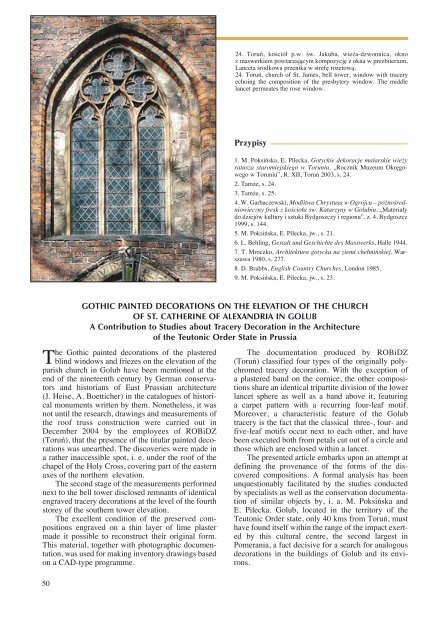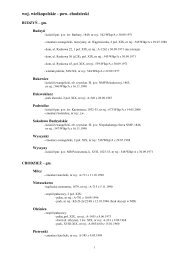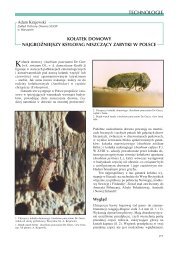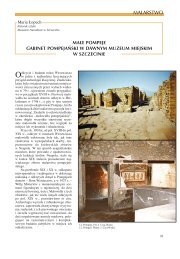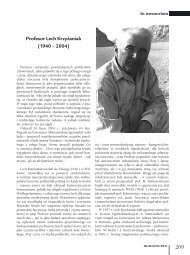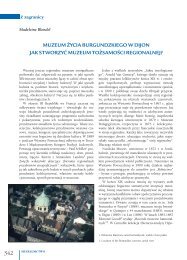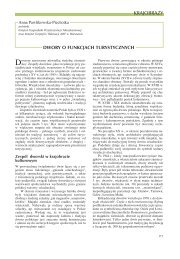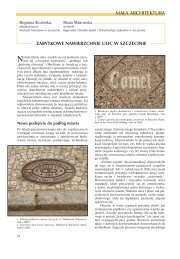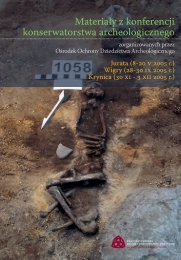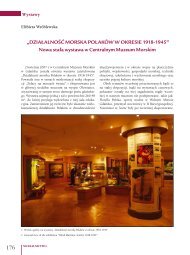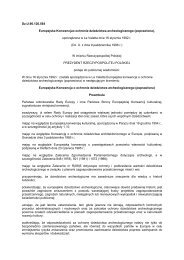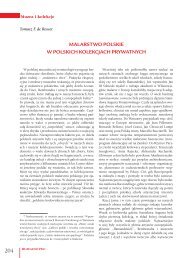Gotyckie dekoracje malarskie elewacji kościoła parafialnego p.w. św ...
Gotyckie dekoracje malarskie elewacji kościoła parafialnego p.w. św ...
Gotyckie dekoracje malarskie elewacji kościoła parafialnego p.w. św ...
Create successful ePaper yourself
Turn your PDF publications into a flip-book with our unique Google optimized e-Paper software.
The Gothic painted decorations of the plastered<br />
blind windows and friezes on the elevation of the<br />
parish church in Golub have been mentioned at the<br />
end of the nineteenth century by German conservators<br />
and historians of East Prussian architecture<br />
(J. Heise, A. Boetticher) in the catalogues of historical<br />
monuments written by them. Nonetheless, it was<br />
not until the research, drawings and measurements of<br />
the roof truss construction were carried out in<br />
December 2004 by the employees of ROBiDZ<br />
(Toruƒ), that the presence of the titular painted decorations<br />
was unearthed. The discoveries were made in<br />
a rather inaccessible spot, i. e. under the roof of the<br />
chapel of the Holy Cross, covering part of the eastern<br />
axes of the northern elevation.<br />
The second stage of the measurements performed<br />
next to the bell tower disclosed remnants of identical<br />
engraved tracery decorations at the level of the fourth<br />
storey of the southern tower elevation.<br />
The excellent condition of the preserved compositions<br />
engraved on a thin layer of lime plaster<br />
made it possible to reconstruct their original form.<br />
This material, together with photographic documentation,<br />
was used for making inventory drawings based<br />
on a CAD-type programme.<br />
50<br />
24. Toruƒ, koÊció∏ p.w. Êw. Jakuba, wie˝a-dzwonnica, okno<br />
z maswerkiem powtarzajàcym kompozycj´ z okna w prezbiterium.<br />
Lanceta Êrodkowa przenika w stref´ rozetowà.<br />
24. Toruƒ, church of St. James, bell tower, window with tracery<br />
echoing the composition of the presbytery window. The middle<br />
lancet permeates the rose window.<br />
Przypisy<br />
1. M. Poksiƒska, E. Pilecka, <strong>Gotyckie</strong> <strong>dekoracje</strong> <strong>malarskie</strong> wie˝y<br />
ratusza staromiejskiego w Toruniu, „Rocznik Muzeum Okr´gowego<br />
w Toruniu”, R. XII, Toruƒ 2003, s. 24.<br />
2. Tam˝e, s. 24.<br />
3. Tam˝e, s. 25.<br />
4. W. Garbaczewski, Modlitwa Chrystusa w Ogrójcu – póênoÊredniowieczny<br />
fresk z koÊcio∏a Êw. Katarzyny w Golubiu, „Materia∏y<br />
do dziejów kultury i sztuki Bydgoszczy i regionu”, z. 4, Bydgoszcz<br />
1999, s. 144.<br />
5. M. Poksiƒska, E. Pilecka, jw., s. 21.<br />
6. L. Behling, Gestalt und Geschichte des Masswerks, Halle 1944.<br />
7. T. Mroczko, Architektura gotycka na ziemi che∏miƒskiej, Warszawa<br />
1980, s. 277.<br />
8. D. Brabbs, English Country Churches, London 1985.<br />
9. M. Poksiƒska, E. Pilecka, jw., s. 23.<br />
GOTHIC PAINTED DECORATIONS ON THE ELEVATION OF THE CHURCH<br />
OF ST. CATHERINE OF ALEXANDRIA IN GOLUB<br />
A Contribution to Studies about Tracery Decoration in the Architecture<br />
of the Teutonic Order State in Prussia<br />
The documentation produced by ROBiDZ<br />
(Toruƒ) classified four types of the originally polychromed<br />
tracery decoration. With the exception of<br />
a plastered band on the cornice, the other compositions<br />
share an identical tripartite division of the lower<br />
lancet sphere as well as a band above it, featuring<br />
a carpet pattern with a recurring four-leaf motif.<br />
Moreover, a characteristic feature of the Golub<br />
tracery is the fact that the classical three-, four- and<br />
five-leaf motifs occur next to each other, and have<br />
been executed both from petals cut out of a circle and<br />
those which are enclosed within a lancet.<br />
The presented article embarks upon an attempt at<br />
defining the provenance of the forms of the discovered<br />
compositions. A formal analysis has been<br />
unquestionably facilitated by the studies conducted<br />
by specialists as well as the conservation documentation<br />
of similar objects by, i. a. M. Poksiƒska and<br />
E. Pilecka. Golub, located in the territory of the<br />
Teutonic Order state, only 40 kms from Toruƒ, must<br />
have found itself within the range of the impact exerted<br />
by this cultural centre, the second largest in<br />
Pomerania, a fact decisive for a search for analogous<br />
decorations in the buildings of Golub and its environs.


